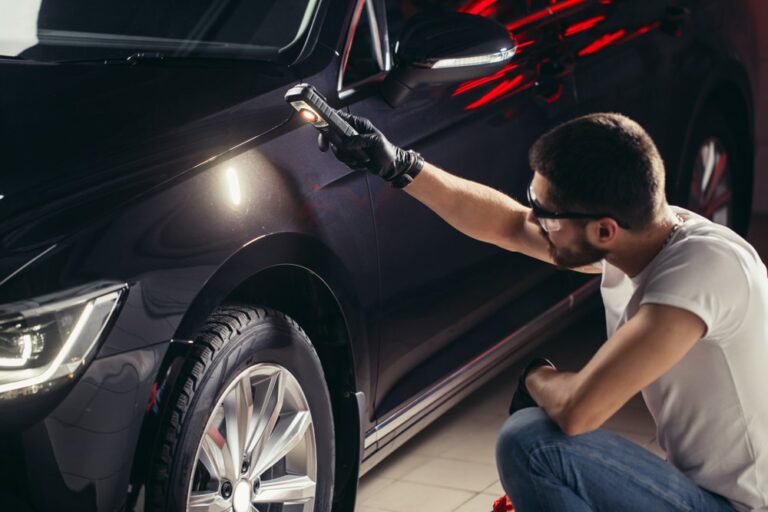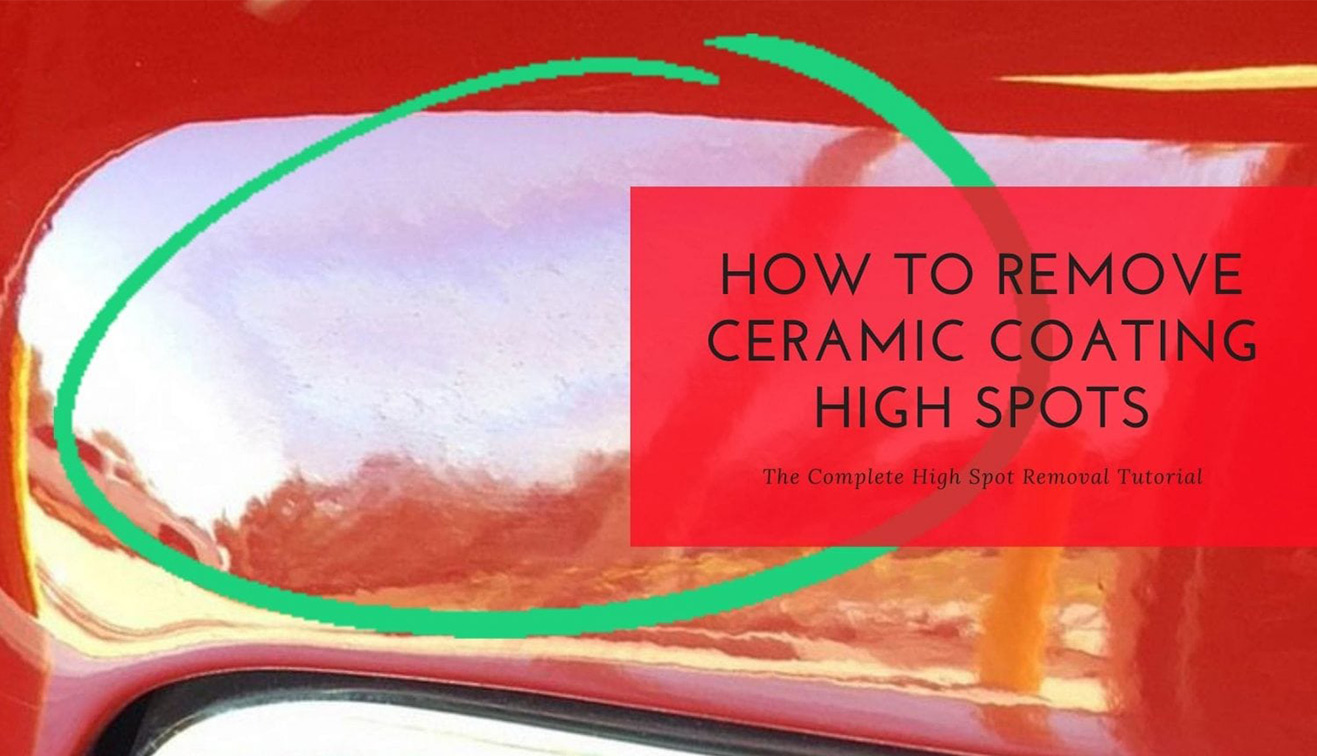You must be cautious when applying ceramic coatings as detailers or professionals in ceramic coatings. High spots are unavoidably one of the most prevalent issues! You have a sheen on your surface that looks like an oil slick or a rainbow.
Let’s examine what leads to high spots and how to prevent them. Please don’t worry; we won’t bore you with the details. We’ll maintain simplicity. Move along!
Why Do High Spots Exist?
Unleveled ceramic coating that has cured or is in the curing process causes high patches. A poor polishing technique or insufficient levelling are two major contributors to high spots. Even commercially available ceramic coatings must be levelled or rubbed off most of the time. However, why is it necessary to level a coating? Coatings don’t they self-level, right?
Detailer Tip #1: To avoid areas of uneven concentration, apply the coating in straight, even lines without raising the product.
Coatings, when applied unevenly (which is entirely common, by the way!), necessitate the need for levelling. When applying any type of coating, the applicator pad or sponge that the detailer uses could transport more or less product than intended, resulting in an uneven coating distribution across the surface. The amount of pressure that is exerted while applying also plays a significant influence. This elucidates the reason why the majority of detailers choose to use an application block!

To get a flawless finish, a coating must be applied uniformly throughout the entire surface, just like butter. When applying, a detailer can accidentally use more product than necessary, resulting in the beginning regions being thicker than the rest of the coating.
Imagine slathering larger globs of butter onto a single slice of bread and spreading them out evenly. A hunk of butter should be spread carefully and methodically to guarantee a uniform coating on the bread. The butter should be cool. On occasion, it is necessary to stretch it out further!
Ceramic coatings, on the other hand, are transparent and only a few microns thick, unlike butter. However, I have a solution to this problem! Remove any extra coating by rubbing it off with a microfiber cloth. This eliminates any surplus coating and ensures that the coating is uniformly distributed across the surface.
It is MUCH MORE CHALLENGING to notice high spots on lighter-coloured automobiles. This is both an advantage and a disadvantage. Lighter-coloured cars are better at concealing their flaws, whereas darker-coloured cars, like black, tend to show off their high spots almost immediately (which also inspires detailers to use more colourful language). One advantage is that defects might not stand out as much as they would. The difficulties arise when the issue becomes apparent, and it is already too late for a simple solution!
Detailer Tip #2: Concentrate on covering only little portions of the car you are working on at a time.
Working in planned little pieces at a time lets you to identify which places you have done, reducing the likelihood of missing spots or adding extra layers. Working in tiny sections allows you to determine which regions you have completed. This not only makes it easy to deal with the curing durations for each panel, but it also makes it easier to go through the order in which the panels were applied.

“What Are the Characteristics Of A High Spot?”
High spots are areas of your paint that are darker or have a rainbow-like appearance. After it has been treated, it will typically become more noticeable. However, because they can conceal themselves well in dim illumination, high areas can be a bit challenging to find. Even to the untrained sight, high spots can be seen if the environment is lit suitably. The experts rely on the appropriate lighting equipment to illuminate the surfaces, making locating any imperfections easier.
You can also inspect your vehicle outside if you do not have access to a suitable lighting setup. Cloudy skies are ideal for inspection since they highlight the dark patchy areas and the rainbow gleams. The appearance that the coating is precisely levelled is created by sunlight shining directly on it. Additionally, it has the effect of curing the paint FASTER, which is something you want to avoid if there are any high spots that need to be fixed.
Detailer Tip #3: A flashlight is typically needed to see the high areas on lighter-coloured vehicles.

It is MUCH MORE CHALLENGING to notice high spots on lighter-coloured automobiles. This is both an advantage and a disadvantage. Lighter-coloured cars are better at concealing their flaws, whereas darker-coloured cars, like black, tend to show off their high spots almost immediately (which also inspires detailers to use more colourful language). One advantage is that defects might not stand out as much as they would. The difficulties arise when the issue becomes apparent, and it is already too late for a simple solution!
Detailer Tip #4:Conduct a thorough inspection of the coating as soon as it has been applied to prevent the damaged areas from hardening any further.

The best method to deal with high spots is to avoid creating them in the first place!
The likelihood of heavy applications is reduced when using a wider and softer block. Nevertheless, the most essential step is to remove any extra coating and bring it to a perfect level using a buffing pad. In addition, we discovered that utilising numerous cloths made of microfiber to level surfaces and remove extra coatings was effective.
The “peaks” of the high places are typically removed after the initial buff is applied. These are the parts that are more substantial and have not cured or flashed as quickly as the others. The second buff evens the coating by distributing it evenly across the surface. A third buff takes care of everything they may have overlooked previously (totally optional).
When the ceramic coating is still wet, how can you verify if it has been applied uniformly throughout the surface? Some people rely on visual clues, such as the presence of a few faint streaks or an odd sheen. While certain people can tell just by using their highly developed sense of touch.
What Am I Supposed To Do If There Is A High Spot?
If you come across a high spot, you should ask yourself, “How long has it been since the car was coated?”
This is extremely important because the solution’s success relies heavily on the length of time the coating has been applied. After you have determined the answer to your inquiry, do some research to determine which of the following options is most suitable for you:
- As soon as you notice it, you wipe it away with a wet towel, and then you buff it away with a dry towel. Reduce the risk of damaging your surface using edgeless microfibers, such as our microfiber coating removal towel. These will assist you throughout the process.
- After several hours, but not more than 12 hours, apply a thin coating layer by placing approximately one to two drops onto an applicator and then applying it over the afflicted region. This will allow the newly applied coating to activate the previously cured coating. When it has finished activating, brush it off to make the coating uniform. The high points will fall, and the overall level will become more even. Be careful not to apply too thick of a coating layer because doing so will worsen the situation.
- It becomes more challenging to eliminate high spots after the substance has entirely cured after a couple of days or more have passed. If something like this happens, you can try to remove it by mechanically cleaning the surface or using an all-purpose cleaner.
- If the ceramic coating cannot be removed (which happens very infrequently), you will need to use a polisher and polishing pads to remove them successfully.

